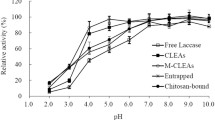Abstract
This work investigates the effect of direct-current electric field on the extracellular enzymatic activity, concentration and other experimental parameters of laccase from Trametes versicolor. The results showed that laccase could significantly contribute to the change of pH at the end of graphite electrode. In addition, it increased the electrical conductivity of the water. In the experiment, the optimum pH and catalytic pH range for laccase activity were 3.0 and pH 2.5–4.0. The application of 6 V direct current showed significant effects on the laccase enzyme activity. The activity of laccase was enhanced in the anodic region, but at the same time was strongly inhibited at the cathode. The electric charge characteristics of laccase were changed when exposed to electric field, and some laccases molecules moved to the anode, which produced a slight migration phenomenon. This study is the basis of combination of laccase and electrical technology, at the same time, providing a new direction of enhancing laccase activity. Compared to immobilization, using electric field is simple, no chemical additives, and great potential.








Similar content being viewed by others
References
Kolb M, Sieber V, Amann M, Faulstich M, Schieder D (2012) Removal of monomer delignification products by laccase from Trametes versicolor. Bioresour Technol 104:298–304. doi:10.1016/j.biortech.2011.11.080
Sheikhi F, Ardakani MR, Enayatizamir N, Rodriguez-Couto S (2012) The determination of assay for laccase of Bacillus subtilis WPI with two classes of chemical compounds as substrates. Indian J Microbiol 52:701–707. doi:10.1007/s12088-012-0298-3
Gomes HI, Dias-Ferreira C, Ribeiro AB (2012) Electrokinetic remediation of organochlorines in soil: enhancement techniques and integration with other remediation technologies. Chemosphere 87:1077–1090. doi:10.1016/j.chemosphere.2012.02.037
Reddy KR, Darko-Kagya K, Al-Hamdan AZ (2011) Electrokinetic remediation of pentachlorophenol contaminated clay soil. Water Air Soil Pollut 221:35–44. doi:10.1007/s11270-011-0767-z
Sharma KK, Kuhad RC (2008) Laccase: enzyme revisited and function redefined. Indian J Microbiol 48:309–316. doi:10.1007/s12088-008-0028-z
She P, Song B, Xing XH, Mark VL, Liu Z (2006) Electrolytic stimulation of bacteria enterobacter dissolvens by a direct current. Biochem Eng J 28:23–29. doi:10.1016/j.bej.2005.08.033
Patel SKS, Kalia VC, Choi JH, Haw JR, Kim IW, Lee JK (2014) Immobilization of laccase on SiO2 nanocarriers improves its stability and reusability. J Microbiol Biotechnol 24:639–647. doi:10.4014/jmb.1401.01025
Carlsson N, Borde A, Wölfel S, Akerman B, Larsson A (2010) Quantification of protein concentration by the Bradford method in the presence of pharmaceutical polymers. Anal Biochem 411:116–121. doi:10.1016/j.ab.2010.12.026
Hu M, Zhou X, Shi Y, Lin J, Irfan M, Tao Y (2014) Essential role of the N-and C-terminals of laccase from pleurotus florida on the laccase activity and stability. Appl Biochem Biotechnol 174:2007–2017. doi:10.1007/s12010-014-1147-0
Zhang JP, Zhao L, Tan X (2004) Structural change of water clusters and the corresponding biological effects. Chemistry 4:278–283. doi:10.3969/j.issn.0441-3776.2004.04.006
Chen B, Hu XH, Li JH, Liu SH (2003) Mechanism of increasing of conductivity of water processed by electro-magnetic field. Biomagnetism 3:69–72. doi:10.3969/j.issn.1001-0548.2008.06.040
Strong PJ, Claus H (2011) Laccase: a review of its past and its future in bioremediation. Crit Rev Environ Sci Technol 41:373–434. doi:10.1080/10643380902945706
Yaropolov AI, Skorobogat’ko OV, Vartanov SS, Varfolomeyev SD (1994) Laccase. Appl Biochem Biotechnol 49:257–280. doi:10.1007/BF02783061
Zhang GQ, Tian T, Liu YP, Wang HX, Chen QJ (2011) A laccase with anti-proliferative activity against tumor cells from a white root fungus Abortiporus biennis. Process Biochem 46:2336–2340. doi:10.1016/j.procbio.2011.09.020
Miao J, Fu DX, Lu XJ (2005) Degradation of phenol in wastewater by ultrasound/titanium-iron double-anodes electric catalysisoxidation system. J China Coal Soc 30:652–655. doi:10.3321/j.issn:0253-9993.2005.05.024
Ivanka S, Albert K, Veselin S (2010) Properties of crude laccase from Trametes versicolor produced by solid-substrate fermentation. Adv Biosci Biotechnol 1:208–215. doi:10.4236/abb.2010.13029
Baldrian P (2004) Purification and characterization of laccase from the white-rot fungus Daedalea quercina and decolorization of synthetic dyes by the enzyme. Appl Microbiol Biotechnol 63:560–563. doi:10.1007/s00253-003-1434-0
Mikolasch A, Schauer F (2009) Fungal laccases as tools for the synthesis of new hybrid molecules and biomaterials. Appl Microbiol Biotechnol 82:605–624. doi:10.1007/s00253-009-1869-z
Cassland P, Jonsson LJ (1999) Characterization of a gene encoding Trametes versicolor laccase A and improved heterologous expression in Saccharomyces cerevisiae by decreased cultivation temperature. Appl Microbiol Biotechnol 52:393–400. doi:10.1007/s002530051537
Dhiman SS, Garg G, Sharma J, Kalia VC, Kang YC, Lee JK (2014) Reduction in acute ecotoxicity of paper mill effluent by sequential application of xylanase and laccase. PLoS One 9:e102581. doi:10.1371/journal.pone.0102581
Singh G, Kaur K, Puri S, Sharma P (2015) Critical factors affecting laccase-mediated biobleaching of pulp in paper industry. Appl Microbiol Biotechnol 99:155–164. doi:10.1007/s00253-014-6219-0
Acknowledgments
This work was supported by the National Natural Science Foundation of China (Grant No. 41201306).
Conflict of interest
None.
Author information
Authors and Affiliations
Corresponding author
Rights and permissions
About this article
Cite this article
Wang, C., Zhang, H., Ren, D. et al. Effect of Direct-Current Electric Field on Enzymatic Activity and the Concentration of Laccase. Indian J Microbiol 55, 278–284 (2015). https://doi.org/10.1007/s12088-015-0523-y
Received:
Accepted:
Published:
Issue Date:
DOI: https://doi.org/10.1007/s12088-015-0523-y




